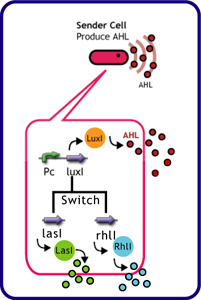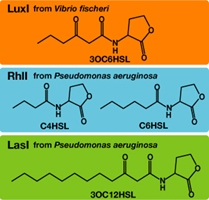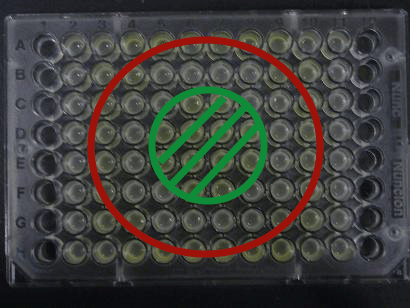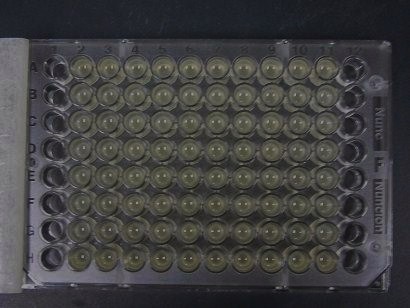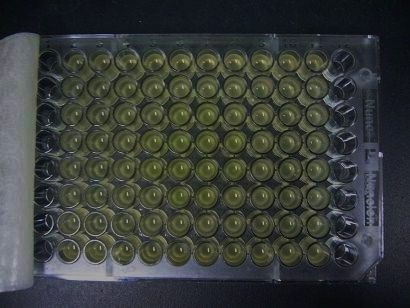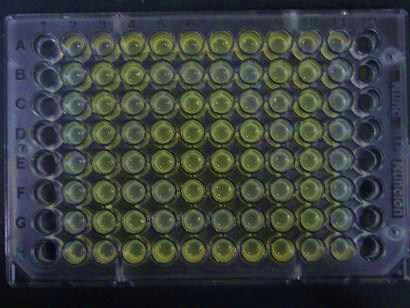Team:Chiba/Project/Experiments:Sender Crosstalk
From 2008.igem.org
(→Future plans) |
(→Design) |
||
| Line 18: | Line 18: | ||
Each species has their own LuxI-type proteins,which synthesize their specific autoinducers,AHLs.AHLs produced by different LuxI-type proteins differ only in the length of the acyl-chain moiety and substitution at position C-3.LuxR,which is original for Vibrio fischeri,is activated by its cognate autoinducer,3OC6HSL.However,LuxR is also activated by non-endogenous molecules,C4HSL,C6HSL,and 3OC12HSL.Activation by non-endogenous molecules requires a higher signal concentration(2).This results in slower activation of receivers,when AHL concentration is increasing. | Each species has their own LuxI-type proteins,which synthesize their specific autoinducers,AHLs.AHLs produced by different LuxI-type proteins differ only in the length of the acyl-chain moiety and substitution at position C-3.LuxR,which is original for Vibrio fischeri,is activated by its cognate autoinducer,3OC6HSL.However,LuxR is also activated by non-endogenous molecules,C4HSL,C6HSL,and 3OC12HSL.Activation by non-endogenous molecules requires a higher signal concentration(2).This results in slower activation of receivers,when AHL concentration is increasing. | ||
| - | + | ||
[[Image:AHL variety chiba.gif|frame|right|'''Fig.2''' AHL varieties]] | [[Image:AHL variety chiba.gif|frame|right|'''Fig.2''' AHL varieties]] | ||
Revision as of 03:54, 30 October 2008
| Home | The Team | The Project | Parts Submitted to the Registry | Reference | Notebook | Acknowledgements |
|---|
Sender Crosstalk
Design
Each species has their own LuxI-type proteins,which synthesize their specific autoinducers,AHLs.AHLs produced by different LuxI-type proteins differ only in the length of the acyl-chain moiety and substitution at position C-3.LuxR,which is original for Vibrio fischeri,is activated by its cognate autoinducer,3OC6HSL.However,LuxR is also activated by non-endogenous molecules,C4HSL,C6HSL,and 3OC12HSL.Activation by non-endogenous molecules requires a higher signal concentration(2).This results in slower activation of receivers,when AHL concentration is increasing.
Experiments
The purpose of this experiment was to create delays in communication time using cross-talk between non-specific signals. We used the following genes for this experiment.
| senders (cell: XL10-Gold or JW1908) | receiver (cell: JW1908) |
| *[http://partsregistry.org/Part:BBa_K084007 plac+rbs+LasI] (pSB1AK3) | *[http://partsregistry.org/Part:BBa_T9002 BBa_T9002 (Express GFP in response to AHL)] (pSB1A3) |
| *[http://partsregistry.org/Part:BBa_K084008 plac+rbs+RhlI] (pSB1AK3) | |
| *[http://partsregistry.org/Part:BBa_K084009 BBa_K084009] | |
| *[http://partsregistry.org/Part:BBa_K084012 plac+rbs+LuxI] (pSB1AK3) | |
| *[http://partsregistry.org/Part:BBa_K084014 BBa_K084014] | |
| *[http://partsregistry.org/Part:BBa_S03623 BBa_S03623(ptet+rbs+LuxI(LVA))] |
Details
Method
To characterize quorum sensing crosstalk, constitutive AHL senders were mixed with constitutive receivers and measure fluorescence intensity.
- Transformed Senders into E.coli strains(XL10Gold) and Receiver into E.coli strain(JW1908).
- Inoculated them independently in liquid media. Incubated at 37°C for 12hours.
- Mixed them.
- Incubated at 30°C.
- Measured intensity of green fluorescence(485 nm(excitation) and 527 nm(emission)) at regular time intervals.
Results & Discussion
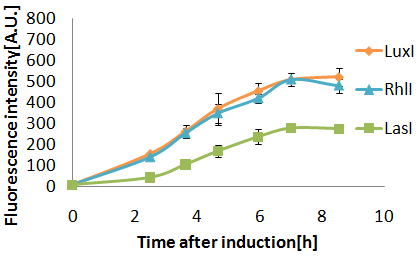
Senders(XL10Gold), T9002(JW1908)@30°C, Sender(μL):Receiver(μL)=500:500, 100:1000, 10:1000
- 37°Cで行った実験と比べ、LasIが活性。(8h後の蛍光強度、37°C:30°C=163:245)
- LasとLux(Plac)1:1で蛍光強度200に達するまでの時間に2.5時間の時差がみられた。
- Rhlのタグなしとタグ付きの差は、8h後の最終強度にしか現れなかった。
- また、差が一番でたのが30°Cで行ったこの実験で、タグなし:タグつき=507:456。
3OC6HSL,3OC12HSLに対する、LuxRの応答時間に、二時間の差ができた(3OC12HSLの場合、3OC6HSLに比べて二時間遅れて応答する)。 (そのときの条件は、培養温度30°C、genelatorの株はXL10Gold,Receiverの株はJW1908のとき、であった。) <??
Future plans
- AHL合成酵素の発現量を減らし,AHL生産速度を遅くする.
- Replace medium RBS with weak one.
- コピーナンバーをlowにする.
- transfer curveをシグモイダルに近づける.
- Positive Feedback Loopを導入する.
Other Experiments
Visual Judgement
- Fluorescence intensity was from 150 to 200 when the 2 mL of reaction culture in a test tube.
試験管内の培養液(2mL)が、緑色を呈しているときの蛍光強度:150~200。
Senders(JW1908), T9002(JW1908)@37°C, Sender(μL):Receiver(μL)=500:500, 100:1000, 10:1000
- CinI+LVAとLuxRのクロストークはどの菌数比でもおこらない。
- Among RhlI, LasI, and CinI+LVA, RhlI+LVA is the easist to cross-talk with LuxR
- Delay time by cross-talk among senders are generated only a range of one hour to amount
to 200 of fluorescence intensity.
Senders(JW1908),T9002(JW1908)@30°C,Sender(μL):Receiver(μL)=500:500,100:1000,10:1000
- 特に37°Cで行ったときと差はない
- BWはクオラムセンシングをしやすい株なので、Senderを変えてもたいした時差が見られなかった。
- 次回からはSender側の株をXL10Gに代えて実験を行う。
Senders(XL10Gold),T9002(JW1908)@37°C, Sender(μL):Receiver(μL)=500:500,100:1000,10:1000
- SenderをBW株にして行った実験よりも、8時間後の蛍光強度が平均で200くらい落ちた。
- Cross-talk between LasI and LuxR is hard in this condition.
Senders(XL10Gold), T9002(JW1908)@25°C, Sender(μL):Receiver(μL)=500:500, 100:1000, 10:1000
- どのSenderもGFP強度20~50の範囲。ネガコン(T9002のみ)の値、40前後と変わらず。
(ただし、静置培養のため、しんとう培養した30°Cや37°Cとは条件が違う。)
Demo ~Senders~
I experimentally tested the sender genes LuxI and LasI which produce the greatest time difference. We mixed bacteria(XL10G) transformed with either the LuxI or LasI genes and bacteria (of the BW strain) transformed with the LuxR gene at a 1:1 ratio and visually observed GFP fluorescence.
Results
Green region: sender=LuxI (50 uL), Red circular region: sender=Las I (50 uL).
Receiver=LuxR (50 uL)
-->more about Demo experiments detail
references
- [http://www3.interscience.wiley.com/journal/119124142/abstract M.K Winson et al.:Construction and analysis of luxCDABE-based plasmid sensors for investigating N-acyl homoserine lactone-mediated quorum sensing.FEMS Microbiology Letters 163 (1998) 185-192]
- [http://partsregistry.org/Part:BBa_F2620:Specificity BBa_F2620:Specificity]
- [http://mic.sgmjournals.org/cgi/content/full/153/12/3923 Paul Williams.:Quorum sensing, communication and cross-kingdom signalling in the bacterial world.Microbiology 153 (2007), 3923-3938]
 "
"

